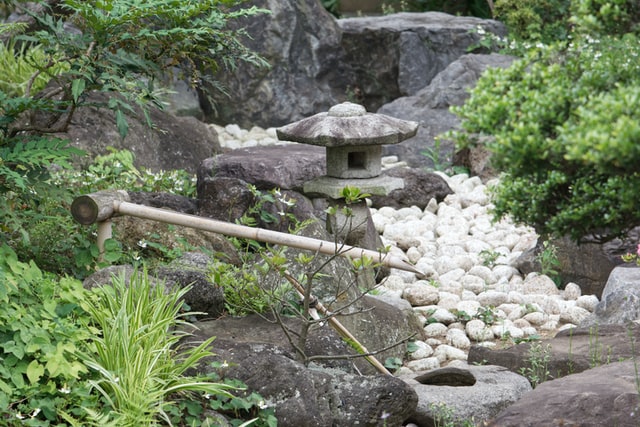How to Make a Rock Garden

If you’ve ever known someone with a rock garden, they’ll tell you they’re beneficial in more ways than one. Not only can rock gardens offer a beautiful landscaping solution, but they’re also economical and extremely functional.
Rock gardens are popular in areas that have dryer climates, such as the western United States. However, due to the versatility and pleasing aesthetics of this particular style of landscaping, rock gardens have gained popularity in recent years all over the country.
If you’ve been looking for the perfect solution to your landscaping needs, a rock garden just might be the answer! In this article, we’ll explore the benefits of rock gardens and give you a simple guide to starting one of your own.
What Are Rock Gardens?
When landscaping is conducted in a fashion that focuses more on rock implementation and placement over grass and other greenery, it’s known as a rock garden. Of course, rock gardens often incorporate flowers and plants into the design, but it’s not the prevalent feature.
What Are the Benefits of Rock Gardens?
Home gardeners and professional landscapers love building rock gardens for the benefits that come with it. You’ll find that rock gardens continue to gain popularity throughout the U.S. for the unique styles they allow in design and for their general usefulness. Take a look at these benefits:
- Style – Rock gardens allow for individual style, flair, and textures to be added to your space that otherwise can’t through other garden types. With the incorporation of colorful rocks and patterns, carefully placed plants, water features, and more, rock gardens can really transform your outdoor space.
- Functionality – Looking for a great place to entertain, or perhaps a solution to front yard landscaping difficulties with grass? Rock gardens not only look great, but they can also function to enhance your life or solve problems.
- Low-Maintenance – One of the main reasons gardeners and landscapers opt for rock gardens is the ease of maintenance. Depending on how many plants and flowers you decide to include in your design, caring for your rock garden can be a snap when you’re mostly dealing with rocks.
- Drought-Friendly – As mentioned earlier, rock gardens are trendy in the western region of the U.S. due to the relatively low water requirements; this can be important in areas that don’t get a tremendous amount of rainfall. With water conservation being critical, however, rock gardens are also picking up speed in all other U.S. regions.
- Seasonal Landscaping – Because the grass, flowers, and plants in gardens are often only enjoyed in-season, it can make for an unappealing landscape during the off-season. Depending on what types of plants you choose to incorporate into your rock garden, this type of landscaping can generally be enjoyed all year long.
Choosing the Style of Your Rock Garden
When you’ve chosen to build your own rock garden, design and style will play an integral part in your plans. Luckily, choosing the style of your new rock garden is the fun part! Here are some popular styles and themes to consider:

- Japanese Zen Garden – If you’re looking for a landscaping resolution that promotes peace and tranquility, the Japanese zen garden might be the best option for you. This rock garden style incorporates carefully placed and delicately balanced combinations of rocks, trees, bushes, water features, gravel, and sand.

- Rock Mosaic – Rock gardens with a mosaic feature focus mainly on patterned walkways and areas. Plants are often incorporated in outlying positions or when the mosaic patterns conclude.

- Desert Theme – Desert theme rock gardens are popular in areas with hot and dry climates due to low water requirements. Desert flowers and cacti often line rock pathways and boulders to make up this garden design.

- Water Feature – Gardens with water features are very popular. With this rock landscaping style, the garden is built around a centrally focused water feature.

- Terrace-Style Rock Garden – Rock gardens that scale upwards in a hill and that tend to incorporate more than usual greenery are considered terrace-style. This design can take some more planning than others, but the results are often stunning.
Planning Your Rock Garden
Once you’ve chosen the design for your rock garden, it’s essential that you take some time to plan all aspects involved to ensure its success carefully. Here are some things to consider:
- Garden Location – Where are you planning to establish your new rock garden? You’ll want to make sure you have enough space for your design and that the area is accommodating for the style you chose.
- Design Layout – Keeping the style of rock garden you’ve chosen in mind, plot out the actual layout you plan to follow with your garden’s construction. This will give you a plan to follow as you construct your space. Remember to incorporate a walking path if needed!
- Soil – The soil used in your rock garden is important. You’ll want to skip rich soils used for standard flower and food gardens and opt instead for a soil combination of topsoil, peat, and gravel.
- Choose Your Rocks and Stones – Choosing the rocks and stones that make up your garden is one of the most critical steps. Depending on your chosen style, you’ll want to be sure the stones you select will support your design and look great in your new space.
- Choosing Your Plants – With rock gardens, plants are considered secondary; however, selecting the right plants to accent and compliment your rock space is crucial. Take some time to find which plants will work best with your rock selections and support the overall feel you want your garden to emulate.
Preparing the Space
Before getting started with the actual construction of your rock garden, you’ll need to clear and prepare the land accordingly. In this stage, unwanted grass, plants, and other debris should be cleared. You’ll also want to consider how level you need your garden to be to support your design.
Laying Your First Rock Layer
Begin by digging about a foot into the ground throughout the area of your new garden. This will help you establish the best place to fill with rocks and allow you to build a drainage layer. You’ll also generally want to use the least visually appealing rocks in the base layer step. It’s important to note that if your rock garden will be incorporating boulders and larger rocks, it’s a good idea to lay those rocks down first and then lay your small rocks around the larger ones.
The drainage layer is important because it will keep water from moving your rocks around or over-saturating any plants you have. Many gardeners choose to use pebbles or gravel while establishing this layer.
Once you’ve laid your first layer of rocks, it’s time to fill in any spaces and gaps with soil. Remember, you’ll want to use a mixture of topsoil, peat, and gravel. This soil combination can support most plant growth in rock gardens and will promote excellent drainage to prevent water pooling. Following the addition of your soil, be sure to smooth and pack down everything you’ve placed.
Finally, most gardeners and landscapers choose to lay down tarps on top of their first rock layers to block new growth from affecting their gardens. You can also use store-purchased growth-resistant fabric or newspaper to inhibit weeds and other vegetation.
Laying Your Second Rock Layer and Border
Your design skills will definitely be needed during this portion of the process. Begin by establishing your garden’s border to surround your prepared area. You’ll want to be sure the rocks you choose for your border will compliment your overall design. Borders should also be established around each area that you plan to install plants or structures and where you plan to build walkways
Following the building of any needed border walls, it’s time to layer your top layer of rock. This could be when you install your mosaic or a fun pattern or generally fill in the space with loose rock. If you plan to incorporate a mosaic into your rock garden, a little more work and concrete will go into the process. Many gardeners choose to lay out loose-rock designs in their gardens; loose-rock designs will have the benefit of adding some flair to your garden space but don’t take nearly as much work and can be changed more easily when desired.
Adding In Plants and Other Design Features
Now it’s time to add in any plants or fun features you want to incorporate into your garden. By having already pre-designed your space and built border walls, adding various elements to your garden should be relatively straightforward. Simply plant any flowers or vegetation you want in the dedicated areas, or place things like benches and water features. You’re all done and ready to enjoy your new rock garden!
Maintaining Your New Garden
Here’s the best part: maintaining most rock gardens is super simple. You’ve already done the hard work of making the area virtually weed-proof. Many rock gardens don’t require much watering due to less greenery and the nature of plant types. Simply pull a weed here and there, ensure your border walls stay in place, and put wayward rocks back into place, and your rock garden should look great for a long time.



